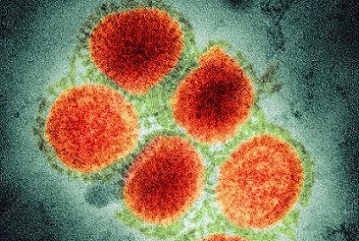Health Authorities Around The World On High Alert As A New Genotype Of H3N2 Flu Virus Has Possibly Emerged In Bogota-Colombia
Nikhil Prasad Fact checked by:Thailand Medical News Team Feb 07, 2024 1 year, 10 months, 6 days, 11 hours, 48 minutes ago
Medical News: In the wake of the recent outbreak at the General José María Córdova Military Cadet School in Bogotá, Colombia, health authorities worldwide have been placed on high alert as a possible new genotype of the H3N2 influenza virus has surfaced. This
Medical News report seeks to delve deeper into the characteristics of the AH3N2 virus, its historical context, symptoms, global response, and the ongoing research that underpins our understanding of this potential health threat.
 New Genotype Of H3N2 Flu Virus Has Possibly Emerged In Bogota-Colombia
Understanding the AH3N2 Virus
New Genotype Of H3N2 Flu Virus Has Possibly Emerged In Bogota-Colombia
Understanding the AH3N2 Virus
The AH3N2 virus belongs to the influenza type A family, renowned for causing seasonal outbreaks with symptoms resembling those of common flu. Despite its seemingly routine nature, this variant has the potential to induce severe respiratory illness, with fatal outcomes. The alarming death of cadet Cristopher Blanco Vásquez at the Military Cadet School has heightened concerns and prompted a thorough investigation into the nature of Severe Acute Respiratory Infection (SARI), which has now infected 268 people.
https://www.elcolombiano.com/colombia/cual-es-la-variante-del-virus-ah3n2-la-gripe-que-tiene-en-cuarentena-a-la-escuela-militar-de-cadetes-en-bogota-EA23676471
Historical Context
The AH3N2 variant has etched its name in the annals of history, tracing its origins back to 1968 when it caused the Hong Kong flu pandemic. The repercussions of this pandemic were dire, claiming the lives of four million individuals in the Asian region. Over the years, the virus has undergone mutations, resulting in subsequent outbreaks globally, such as the Australian flu in 2017-2018. Despite its periodic reappearances and the constant emergence of newer genotypes, the contagion characteristics of the H3N2 virus remain consistent with seasonal influenza, as emphasized by the Centers for Disease Control and Prevention (CDC) in the United States.
Symptoms and Severity
The symptoms associated with the AH3N2 variant closely mirror those of seasonal influenza, encompassing fever, cough, runny nose, muscle aches, nausea, vomiting, and diarrhea. The U.S. CDC advises that infection control measures for this variant align with those for seasonal influenza. However, the complexity of this disease lies in its potential to escalate into severe respiratory illness, highlighting the need for heightened awareness and monitoring of cases.
COVID-19 Induced Immune Dysfunction
Some experts warn that as a result of SARS-CoV-2 induced dysfunctional immune systems in many and even immunodeficiency in some, infection with the H3N2 could possibly end up with more severe conditions.
Global Impact and Transmission
The World Health
Organization (WHO) underscores the potential health impact of the AH3N2 variant, citing the risk of a pandemic due to its efficient transmission. The virus exhibits the ability to infect birds and mammals, and historical data reveals instances of transmission from pigs to humans, culminating in significant outbreaks. The rapid transmission of the virus is evident in its historical timeline, with outbreaks surfacing in different continents over the years, emphasizing the need for global vigilance.
Evolution and Reassortment
The H3N2 subtype of influenza A is characterized by its rapid evolution, primarily driven by antigenic drift. Amino acid substitutions in the hemagglutinin (HA) and neuraminidase (NA) surface glycoproteins enable the virus to evade immunity induced by prior infection or vaccination. Significantly, the NA protein's evolution contributes to the changing antigenic properties and dynamics of influenza viruses. Reassortment, the exchange of genetic material between different influenza subtypes, can create novel genotypes, sometimes leading to the emergence of more virulent viruses.
Global Surveillance and Response
In response to the emergence of the AH3N2 variant in Bogotá, health authorities globally are intensifying surveillance efforts. The Global Initiative on Sharing All Influenza Data (GISAID) EpiFlu database plays a pivotal role in monitoring the dynamics of reassortment. With the advancement in sequencing technology, thousands of influenza genomes are sequenced annually, providing valuable insights into the evolution and reassortment of the virus.
Ongoing Research and Scientific Insights
Research on influenza antigenic evolution primarily focuses on Hemagglutinin or HA, where amino acid substitutions in epitope regions alter the antigenic phenotype of the virus. However, recent studies have shed light on the importance of anti-NA (neuraminidase) antibodies in protective immunity through natural infection and vaccination. This highlights the substantial contribution of NA evolution to the changing antigenic properties and dynamics of influenza viruses.
The abundance of genomic data, facilitated by advancements in sequencing technology, enables a high-resolution analysis of the dynamics of reassortment. Thousands of 'full' viral genomes are now sequenced annually, with direct clinical samples being analyzed to avoid issues related to virus evolution during in vitro propagation. This wealth of data allows for a comprehensive understanding of the evolution of influenza viruses and aids in the prediction of potential threats.
Conclusion
The recent outbreak of the AH3N2 variant in Bogotá, Colombia, serves as a stark reminder of the persistent threat posed by influenza viruses and the importance of global vigilance. Understanding the historical context, symptoms, and transmission characteristics of the H3N2 virus is crucial for effective surveillance and response strategies. The ongoing research on influenza antigenic evolution, reassortment dynamics, and global genomic data sharing are instrumental in enhancing our preparedness against potential pandemics.
As the world grapples with the challenges posed by emerging infectious diseases, collaborative efforts and a proactive approach are essential to mitigate the impact on global health. The unfolding situation in Bogotá underscores the need for continued research, data sharing, and a coordinated global response to effectively combat and contain the spread of potentially lethal influenza variants. By staying ahead of the curve through scientific insights and international collaboration, we can bolster our defenses against future health threats and protect the well-being of communities worldwide.
For the latest on H3N2, keep on logging to Thailand
Medical News.
